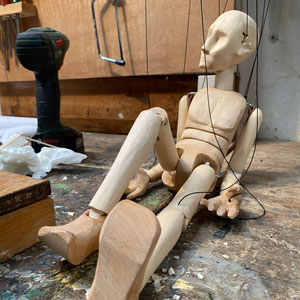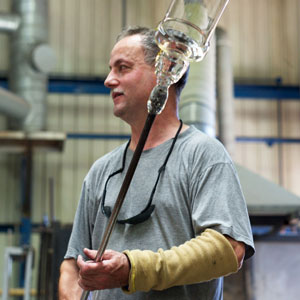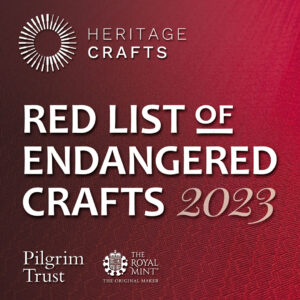Craft skills under threat with 17 additions to the Red List of Endangered Crafts
11th May 2023 | ANNOUNCEMENTS | RED LIST NEWS

New research by Heritage Crafts has unearthed more traditional craft skills on the verge of extinction in the UK, in the latest major update of its pioneering project, the Red List of Endangered Crafts.

Oliver Hymans marionette maker
The research, which has been funded by The Pilgrim Trust with additional sponsorship from The Royal Mint, has found that the energy crisis and inflation has only exacerbated the issues faced by our most at-risk skills, building on the cumulative effect of COVID-19, continuing uncertainties around Brexit and structural issues relating to the funding for skills transmission.
- Click here to go to the Red List
- Click here to view the 2023 list of crafts
- Download the press release
Five new crafts have been added to the ‘critically endangered’ category of the Red List, meaning that they are at serious risk of dying out in the next generation, including straw hat making and encaustic tile making. They join the list of 146 at-risk crafts, including six that have been reclassified as being in greater danger than when the research was last updated in 2021, such as violin bow making and hat block making.
Critically endangered crafts include those with very few practitioners, few (if any) trainees and a lack of viable training routes by which the skills can be passed on. Often they serve very niche markets, and craftspeople cannot afford to step away from production to train their successors for fear those markets will disappear. New crafts in the ‘endangered’ category include Cornish hedging, marionette making and pigment making.

English Antique Glass Ltd
One craft has become extinct in the UK since the publication of the last edition. Mouth-blown flat glass was produced by English Antique Glass in Birmingham until 2022, at which point they were forced to stop production as a result of pressures to reduce their workshop space. This is one of the reasons that the making and restoration of historic stained glass windows has also been added to the Red List, demonstrating the knock-on effect losing one craft can have on others.
It’s not all bad news, however, as some crafts, such as brilliant cutting and shinty stick making, have seen an upturn in their fortunes and moved out of the ‘critically endangered’ category. In many cases this has been as a result of a new-found appreciation of the handmade and the need to support small businesses during the pandemic. In others it has been due to direct support from Heritage Crafts, which since the publication of the last edition of the Red List has distributed 57 grants of up to £2,000 each as part of its Endangered Crafts Fund.
Mary Lewis, who led the research on behalf of Heritage Crafts, said:
“The effect of the energy crisis, inflation, COVID-19 and Brexit have been tough on everyone, not least the craftspeople who possess our most fundamental craft skills. We know that heritage craft skills operate like an ecosystem; if we lose one part it can have devastating consequences on other parts of the system. If we allow endangered crafts to disappear then we seriously diminish the opportunities for future generations to create their own sustainable and fulfilling livelihoods and deal with the challenges of the future.”
Whilst the UK has been a world-leader in the preservation of tangible heritage (museum collections, buildings and monuments), it has fallen behind the rest of the world when it comes to the safeguarding of intangible heritage (knowledge, skills and practices). Of 193 UNESCO members, the UK is one of just 12 that have not yet ratified the 2003 Convention on the Safeguarding of Intangible Heritage, and government responsibility for heritage crafts falls in the gap between agencies set up to support arts and heritage.
Jay Blades MBE, Heritage Crafts Co-Chair said:
“When craft skills are in danger of dying out it’s important that we know exactly where to focus our efforts. Over recent years the Red List of Endangered Crafts has made us realise exactly what we are at risk of losing, and has given our team at Heritage Crafts the information we need to direct our support most effectively. As Co-Chair I’m delighted to endorse this 2023 edition as the next step in turning the tide of craft decline.”
Sue Bowers, Director of the Pilgrim Trust, said:
“We are delighted to support the continuing development of the Red List which is so important in tracking the state of heritage crafts in the UK and creating the platform for discussions about how we can bring about positive change in the future.”
Paul Morgan, The King’s Assay Master at The Royal Mint said:
“The Royal Mint is proud to celebrate, protect and champion British craftsmanship, and we see supporting Heritage Crafts and the Red List of Endangered Crafts as an essential part in this. With precious metals crafts, such as hand engraving and coppersmithing, featuring on this years endangered list, we feel passionately that these skills cannot die out, so by supporting Heritage Crafts and their Red List, alongside recently awarding five bursaries to those working in the fields, we can not only help to preserve these skills in order to ensure the longevity of these crafts for the future, but to really celebrate the talented craftsmen and women behind them.”
The Red List of Endangered Crafts 2023 edition is available to view online. There is also an accompanying print publication sponsored by The Royal Mint.
About the Red List of Endangered Crafts
 The 2023 edition of the Red List of Endangered Crafts was led by Mary Lewis, Heritage Crafts’ Endangered Crafts Manager, supported by the Pilgrim Trust. The project runs alongside Mary’s work in identifying and developing interventions to improve the prospects of such crafts, funded by Swire Charitable Trust and others.
The 2023 edition of the Red List of Endangered Crafts was led by Mary Lewis, Heritage Crafts’ Endangered Crafts Manager, supported by the Pilgrim Trust. The project runs alongside Mary’s work in identifying and developing interventions to improve the prospects of such crafts, funded by Swire Charitable Trust and others.
For the 2023 edition, 259 crafts have been assessed to identify those which are at greatest risk of disappearing. Of the 146 crafts featured on the Red List, 62 have been classified as critically endangered and 84 as endangered. The remaining 112 are classed as currently viable.
For the purposes of this research, a heritage craft is defined as “a practice which employs manual dexterity and skill at the point of production, an understanding of traditional materials, design and techniques, and which has been practised for two or more successive generations.” The research focuses on craft practices which are taking place in the UK today, including crafts which have originated elsewhere.
Drawing on information such as the current number of craftspeople and trainees, the average age of practitioners, opportunities to learn, and other issues affecting the future of the crafts, including the impact of the energy crisis, the research assesses how likely it is that the craft skills will be passed on to the next generation. From armour making and arrowsmithing to wig making and woodturning, each has been assigned to one of four categories: extinct, critically endangered, endangered or currently viable.
One craft (mouth blown flat glass making) is known to have become extinct in the UK since the publication of the 2021 edition, adding to four more in the last fifteen years (cricket ball making, gold beating, lacrosse stick making, and paper mould and deckle making), with one more (sieve and riddle making) brought back from extinction. At the other end of the spectrum, viable crafts are defined as those for which there are sufficient craftspeople to pass on the craft skills to the next generation, though crafts in the currently viable category face real challenges and require continued monitoring.
The original 2017 Red List, funded by The Radcliffe Trust and led by Greta Bertram, was the first to rank traditional crafts by the likelihood they would survive the next generation, bringing the plight of these skills to national attention.
New crafts for 2023
New critically endangered crafts
Crafts classified as ‘critically endangered’ are those at serious risk of no longer being practised in the UK. They may include crafts with a shrinking base of craftspeople, crafts with limited training opportunities, crafts with low financial viability, or crafts where there is no mechanism to pass on the skills and knowledge.
- Arrowsmithing (reclassified from 2021)
- Bow making (musical, reclassified from 2021)
- Chain making
- Coppersmithing (reclassified from 2021)
- Encaustic tile making
- Hat block making (reclassified from 2021)
- Plume making
- Silk ribbon making
- Straw hat making
- Sussex trug making (reclassified from 2021)
- Whip making (reclassified from 2021)
New endangered crafts
Crafts classified as ‘endangered’ are those which currently have sufficient craftspeople to transmit the craft skills to the next generation, but for which there are serious concerns about their ongoing viability. This may include crafts with a shrinking market share, an ageing demographic or crafts with a declining number of practitioners.
- Bicycle frame making (reclassified from 2021)
- Boat building (traditional wooden boats, reclassified from 2021)
- Canal art and barge painting
- Composition picture frame making
- Cornish hedging
- Fairground art
- Gauged brickwork
- Graining and marbling
- Hand engraving (reclassified from 2021)
- Hand hewing
- Lacquerwork
- Marionette making
- Mechanical organ making
- Pigment making
- Sgian dubh making
- Silk weaving
- Spar making
- Stained glass window making (historic)
- Vardo art and living waggon crafts
About the Endangered Crafts Fund
Heritage Crafts’ Endangered Crafts Fund was set up in 2019 to ensure that the most at-risk heritage crafts within the UK are given the support they need to thrive. The Fund is used to support makers and trainees who wish to develop or share their skills in the crafts that have been identified as being most at risk.
To date, 57 projects have been funded with support from the Pilgrim Trust, the Radcliffe Trust, the Dulverton Trust, Swire Charitable Trust, Sussex Heritage Trust, Allchurches Trust and Garfield Weston Foundation. Anyone wishing to donate to the fund may do so securely online via the web link below. Alternatively, please send a cheque made payable to ‘The Heritage Crafts Association’ with an accompanying note specifying ‘Endangered Crafts Fund’ to: Heritage Crafts, 27 South Road, Oundle, Peterborough PE8 4BU.
About Heritage Crafts
Founded in 2009, Heritage Crafts is a Charitable Incorporated Organisation (CIO) registered as the ‘Heritage Crafts Association’, the advocacy body for traditional heritage crafts. Working in partnership with government and key agencies, it provides a focus for craftspeople, groups, societies and guilds, as well as individuals who care about the loss of traditional crafts skills, and works towards a healthy and sustainable framework for the future. Its aim is to support and promote heritage crafts as a fundamental part of our living heritage.
About the Pilgrim Trust
The Pilgrim Trust is an independent grantmaking trust that supports the urgent and future needs of the UK. It gives approximately £3 million in grants per year to charities and other public bodies that either focus on preserving the UK’s heritage or catalysing social change. Its preservation and scholarship fund aims to preserve the fabric of historically important buildings and to conserve significant collections and artefacts. It wants present and future generations to enjoy the rich and diverse heritage found throughout the UK.
About The Royal Mint
The Royal Mint’s expertise in precious metals spans over a thousand years. Known as the home of precious metals in the UK, The Royal Mint offer products including gold, silver and platinum commemorative coins, bars for investment, and a digital gold saving option, backed by metal held in their vault. Last year they announced plans to build a factory to recover precious metals from electronic waste, currently active at lab level. Recovered metal is being used to create beautiful jewellery pieces in their latest business venture, 886 by The Royal Mint.
